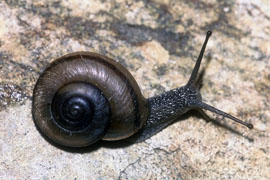By Samantha Bare / Cronkite News
WASHINGTON – The U.S. Fish and Wildlife Service announced Tuesday that it will begin a yearlong review to determine whether the Sonoran talussnail is threatened, specifically by the proposed Rosemont Copper mine.
The action is in response to a petition by the Center for Biological Diversity, which claims that the snail is just one of several species of plants and animals threatened by the proposed mine southeast of Tucson.
“They’re going to blast a mile-wide open pit,” said Tierra Curry, a conservation biologist for the center. “That would literally just blow up the populations of the snail.”
But Kathy Arnold, the vice president for environmental and regulatory affairs at Rosemont Copper, said the mine will not harm the snail population, calling the center’s claims a “fabrication” and “overstatements.”
“The U.S. Forest Service is working through an environmental impact statement,” Arnold said. “They are the ones, along with the Fish and Wildlife Service, who will decide what kinds of impacts we will have, not the Center for Biological Diversity.”
Tuesday’s announcement will not have an immediate impact on the development of the mine while the government spends the next 12 months evaluating the snail’s population. But Fish and Wildlife will take the mine’s potential impact on the snail into consideration during its review, said Steve Spangle, a field supervisor for a Fish and Wildlife Service office in Arizona.
“We look at all the threats to any species,” Spangle said. “Certainly if we look at any project, whether it’s a mine, logging, grazing or whatever, we certainly look into that.”
But even if the service determines after its review that the snail should be a candidate for protection under the Endangered Species Act, Spangle said it would not become eligible for listing until 2016 at the earliest.
He said the agency has been trudging through a backlog of cases resulting from the 2011 settlement of a Center for Biological Diversity lawsuit over the status of 757 species nationwide.
“We can only do so much. The more these (endangered species petitions) keep piling on, the more we’ll deal with them, but through 2016 our listing schedule is set,” Spangle said. “We only have a finite amount of resources.”
The center filed another suit against the Fish and Wildlife Service in June, saying it failed to meet a 12-month deadline to answer an endangered species petition for Coleman’s coralroot, an orchid that Curry said would also be impacted by the mine.
Curry said the center is most concerned with the mine’s impact on the snail, which it calls “rare,” but that it is also worried about the effect of grazing, fire, invasive plants and drought.
The center is also seeking protection for the Rosemont talussnail.
A spokesman for Fish and Wildlife noted that the number of Sonoran talussnails is unknown and that there is an overall dearth of data on the species.
“We do recognize the threat from fire-carrying invasive plants and potentially mining,” Jeff Humphrey, the spokesman, said in an email. “That together with the lack of current information is why we’ve initiated a more thorough status review and are earnestly seeking additional information regarding the Sonoran talussnail.”
Arnold said it is hard to see how a snail can be termed rare when no survey has been done on its population in almost 40 years.
“To say that they’re rare is like saying you lose something and it’s all of a sudden rare, even though you haven’t found it because you haven’t looked for it,” she said.


Reblogged this on NonviolentConflict.